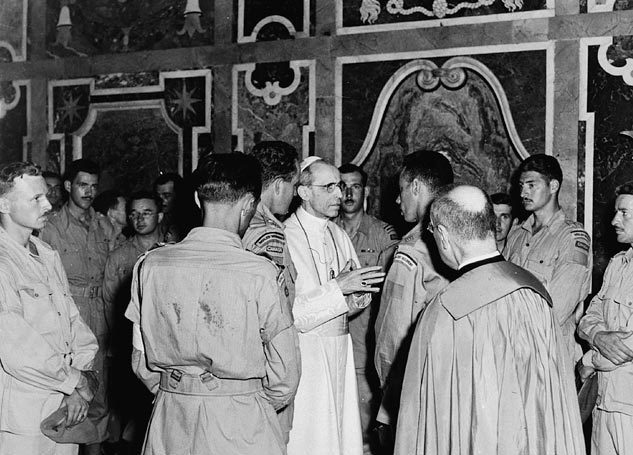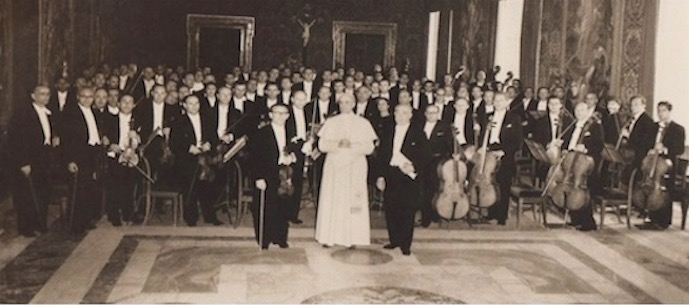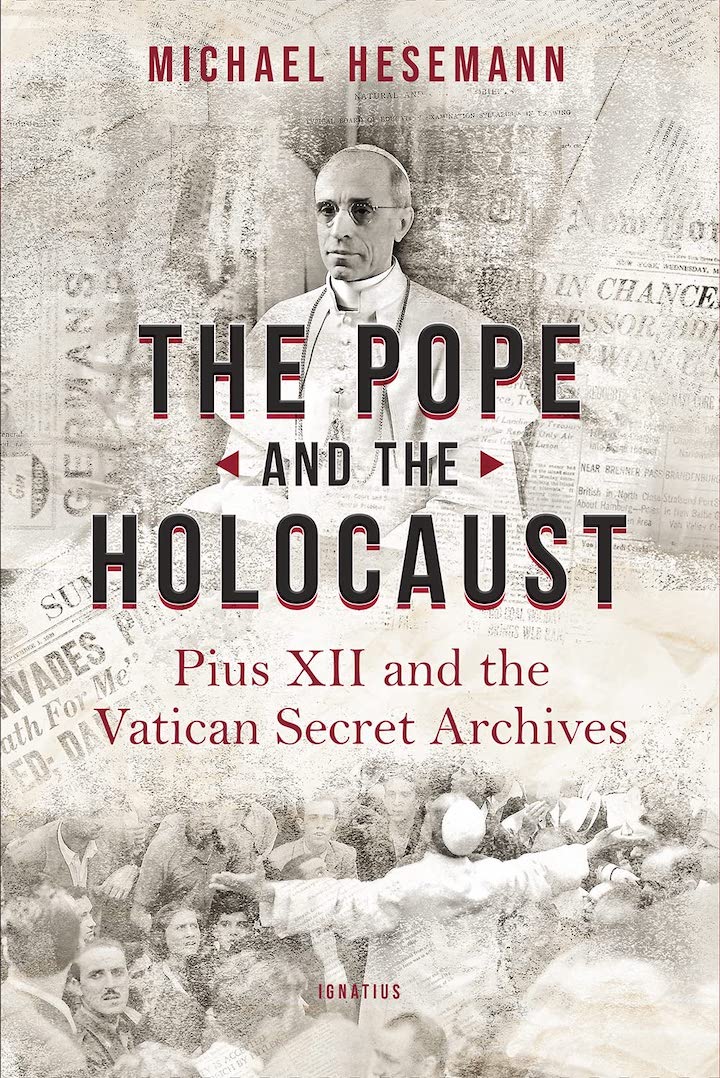At the end of the Second World War, Pope Pius XII was universally acclaimed for his courageous leadership. The Jewish historian Pinchas Lapide acknowledged that the Church saved the lives of 850,000 Jews in Slovakia, Croatia, Romania, and Hungary. Rome’s chief rabbi, Israel Zolli, converted to Catholicism. To thank and honor Pope Pius XII, he took the name Eugenio, after Eugenio Pacelli, the pope’s birth name.
When Pius XII died, Israel’s Foreign Minister Golda Meir wrote, “When fearful martyrdom came to our people in the decade of Nazi terror, the voice of the pope was raised for the victims.” Leonard Bernstein asked the audience at a performance of the New York Philharmonic Orchestra for a minute of silence “for the passing of a very great man, Pope Pius XII.”
Within five years after the pope’s death, however, efforts began to calumniate Pius. Soviet disinformation sought to discredit him. But it was especially the 1963 play, The Deputy, by Rolf Hochhuth, an unknown clerk at a German publishing house and a radical leftist, that painted Pius XII as a pro-Nazi anti-Semite who was silent while 6-million Jews were murdered.
The actual record did not stop the slander. Robert Graham S.J., a scholar of the period, was asked to explain why. With all the gruesome information coming out about the Nazi death camps in the 1960s and 1970s, someone “needed to be blamed for the Holocaust.” And a pope fit the bill.
Since 2020, the full Vatican archives on Pius XII have been opened to scholars. This summer, two books have appeared based on that archival material: The Pope and the Holocaust: Pius XII and the Vatican Secret Archives by German historian Michael Hesemann; and The Pope at War: The Secret History of Pius XII, Mussolini, and Hitler by Brown University professor David I. Kertzer.
Hesemann’s meticulous research reveals Eugenio Pacelli to have been an outspoken critic of the Nazis throughout the 1920s and 1930s. In a 1935 public letter to the bishops of Cologne, for example, Pacelli called the Nazis “false prophets with the pride of Lucifer.” He was also the principal author of Pius XI’s encyclical, written in German and released on Passion Sunday in 1937, With Burning Concern (Mit brennender Sorge), which condemned Nazi racial theories:
Whoever exalts race, or the people, or the State or a particular form of State, or the depositories of power, or any other fundamental value of the human community. . . .above their standard value and divinizes them to an idolatrous level, distorts and perverts an order of the world planned and created by God.
The Nazis called Pacelli a “Jew-loving” cardinal.
After learning of the 1938 Kristallnacht attack on Jews, he formed a plan that would enable 200,000 people “who were considered Jews by the Third Reich, to emigrate and, thereby, to save them from further persecution.” If the various governments issued visas, the Vatican would cover the relocation costs. Although Pacelli labored mightily, Hesemann reports that, because of “a lack of cooperation from governments,” only a few thousand were able to emigrate.
One month after the outbreak of the Second World War, Pacelli, now Pope Pius XII, released his first encyclical, On The Unity of Human Society, which called on all people of goodwill to oppose “two pernicious errors”: racism and statism. He bluntly stated that the Nazis “abandoned Christ’s cross for another which brings only death.”
The New York Times declared on its front page: “Pope Condemns Dictators, Treaty Violators, Racism.” The American Israelite praised the pope’s “denunciation of Nazism.”

In his annual Christmas radio addresses, the pope regularly condemned Nazi barbarism. A 1941 New York Times Christmas editorial declared: “The voice of Pius XII is a lonely voice. . . .[He] is about the only ruler left on the continent of Europe who dares to raise his voice at all. [He] left no doubt that the Nazi aims are also irreconcilable with his own conception of Christian peace.”
Pius XII gave his blessing to German resistance groups dedicated to deposing Hitler; their cause was morally sound because “we had to wage war against the powers of evil.”
On several occasions, Hitler ordered Pius to be kidnapped and Curia members executed. Although Hitler was talked into rescinding those orders, Pius prepared for the worst. He signed a Letter of Resignation – to take effect if he were taken prisoner. In that case, the cardinals were to travel to neutral Portugal and hold a conclave to elect a new pope.
After the Germans occupied Rome in October 1943, Heinrich Himmler ordered that the “Final Solution” be implemented there. “All 8,000 Roman Jews,” Hesemann reports, “regardless of age, sex, or state of health, were to be deported to the Reich ‘for the purpose of liquidation.’”
Hesemann discovered that on October 25, 1943, Pope Pius ordered in writing that “religious institutes and even the catacombs be opened for the Jews who were being persecuted by the Nazis.” The pope sent food from the Vatican to feed thousands housed in Catholic institutions. He spent his own money on medicine, clothes, and other necessities; and he posted guards to protect compounds.
Hundreds of Jews were hidden on Vatican territory including the pope’s summer residence, Castel Gandolfo. “Of the 7,705 Jews living in Rome on June 5, 1944, the day of the liberation by the Allies,” documents indicate 6,681 owed their rescue directly to the pope.
But as in his previous works on Pius, Kertzer appears to be a historian in search of data to confirm a pre-conceived conclusion: that Pius XII did nothing to protect Jews.
In a review of Kertzer’s The Popes Against the Jews, prominent American philosopher Russell Hittinger noted that the author failed to read papal condemnations of anti-Semitism, because “reading the public documents would cut against his thesis at every point.”
Kertzer’s latest book has similar problems.
About half the text traces the decline and fall of Mussolini, Hitler, and the House of Savoy. The other half portrays Pius XII as a weak, indecisive, incompetent, and unbending tyrant who turned a blind eye to the Holocaust and looked favorably on Fascists and Nazis. As the archival material indisputably shows, this is utterly preposterous.
Kertzer even goes so far as to claim that Pacelli was not a favorite of the Cardinals at the 1939 conclave. He falsely asserts that it took three ballots for Pacelli to get the votes required.
The conclave that elected Pacelli was the shortest since 1623. He received forty-eight votes on the second ballot, but as Hesemann rightly observes, “he insisted on a third ballot, in which he received sixty-one of the sixty-two votes, only his own went to another candidate.”
Kertzer’s arguments rest on facts such as that Pius XII dealt with the head of the Italian state, King Victor Emanuel, and the head of the government, Benito Mussolini, to protect Catholic interests; he argued for peace, not war; and he used them as intermediaries with Hitler in attempts to broker a peace agreement.
Kertzer is appalled that Pacelli, as Cardinal Secretary of State and as pope, dealt with Hitler’s government and had “secret” meetings with German envoys.
Pius XII and his predecessor, Pius XI, recognized Hitler was evil, of course, but they negotiated with the German state to secure the Church’s freedom to educate youth and appoint bishops – and for German Catholics to practice their faith freely.
Popes reaching out to rogue states is hardly unusual. To protect the flock, in the 1920s Pius XI attempted, on at least three occasions, to establish diplomatic relations with the Soviet Union.
Kertzer, to be sure, does not mention Pacelli’s documented efforts to save 200,000 “non-Aryans” after Kristallnacht.
Or that, as Pius XII, he supported the resistance movement that sought to overthrow Hitler.
And Kertzer dismisses Nazi plans to kidnap Pius XII as “Allied propaganda.”
He asserts “there is no evidence the pope ever directed Church institutions to take in Jews,” a false statement, as archival materials show beyond all doubt.
Throughout The Pope at War, the author disparages Pius XII’s public statements and speeches. He complains the pope used “opaque theological language and moralistic bromides” and spoke in a “monotonous tone devoid of any hint of spontaneity.”
Pius XII’s sermons are – in this view – too long; his language “characteristically convoluted” or ambiguous. And the pope’s Christmas radio talks are dismissed as “long and of . . . rarified language.”
The pope’s messages may be too opaque for Kertzer but were not so for millions of Catholics and Jews throughout the world at the time, including the New York Times, which was owned by a Jewish family. They understood the pope’s message and hailed him for his courage.
Pius XII gave a radio address on August 1, 1941, for example, that is far from convoluted or ambiguous:
A great scandal is presently taking place, and this scandal is the treatment suffered by the Jews; that is why I desire that a free voice, the voice of a priest, should be raised in protest. In Germany, the Jews are killed, brutalized, tortured because they are victims bereft of defense. How can a Christian accept such deeds?. . . . These men are the sons of those who 2000 years ago gave Christianity to the world.
Despite such words, Kertzer’s primary accusation against Pius XII is his alleged “silence.” Kertzer claims, without evidence, that the pope was intimidated by Hitler and Mussolini and “clung firmly to his determination to do nothing to antagonize either man.” Hence, he concluded that “as a moral leader, Pius XII must be judged as a failure.”
Pope Pius XII was far from silent, but he was certainly cautious. He instructed local bishops that they must “deliberate whether and to what extent the dangers of retaliatory measures and forms of pressure. . .make it seem advisable. . .to exercise restraint ad maiora mala vitanda [in order to avoid greater evils.].”
There were sound reasons for caution.

A papal letter to be read in every church was smuggled into Poland by a Vatican envoy and delivered to Archbishop Sapieha of Krakow in August 1942. The letter was “a declaration of solidarity and a clear repudiation of the Nazis.” But Sapieha lamented, “For the love of God, though, it is absolutely impossible for me to forward this letter. . .to my priests, much less can I have it read out. If only one copy gets into the hands of the SS, all our heads will roll.”
Sapieha burned the letter and told the pope, “It sorely torments us that we cannot forward the letter of Your Holiness to our faithful, but it would serve as a pretext for further persecutions.”
Unlike the Polish Church, the Dutch Church paid a price for its lack of caution. In July 1942, a pastoral letter inspired by the pope and signed by the Dutch Catholic bishops and leaders of the Synod of Dutch Reformed Churches was read from the pulpit in every Catholic Church.
Within a week, the Nazis retaliated by shipping 40,000 Dutch Jews in Holland, including all the Jewish-Catholics, to Auschwitz, among them Edith Stein (Saint Teresa Benedicta of the Cross). The Archbishop of Utrecht, Jan de Jong, later lamented, “If I had remained silent and not protested, all these Jewish Catholics would still be alive.”
Dr. Jozef Lichten, a Polish Jew and director of the Intercultural Division of the Anti-Defamation League of B’nai-Brith, argued that it was wise for the pope not to speak out more strongly against Nazi persecutions “because anything he would have said was liable to make matters even worse for the Jews.”
Marcus Melchior, the chief rabbi of Denmark, a Holocaust survivor, agreed: “If the pope had spoken out, Hitler would probably have massacred more than six million Jews and perhaps ten times ten million Catholics, if he had the power to do so.”
A leading Roman Jew, Carlo Sestieri, who survived by hiding in a Vatican building, stated that the Vatican’s “prudent policy,” saved thousands of Roman Jews, “without doubt it saved, it helped avoid worse disasters.”
Throughout the war, Pope Pius XII struggled with the temptation to speak out. “He did not,” Hesemann writes, “want to purchase for himself the applause of the civilized world and fame in future generations with the blood of innocent persons.”
Thus, he avoided public denunciations that would anyway have been suppressed by Nazi censors and used his position to rescue as many Jews as possible through diplomatic and underground channels.
While some diplomatic initiatives succeeded, the great success was the underground network developed after Pius XII sent a secret order to the bishops in Europe on December 23, 1940, that directed them to provide aid for “all people who suffer from the racism of National Socialism.”
Priests, nuns, and other religious carried out the pope’s order and saved lives through bold and intelligent tactics. The noted historian, John Toland, reflecting on those noble efforts, wrote in his acclaimed biography of Hitler:
The Church under the pope’s guidance. . .saved the lives of more Jews than all other churches, religious institutions, and rescue operations combined. . . .The record of the Allies was far more shameful. The British and Americans, despite lofty pronouncements, had not only avoided taking any meaningful action, but gave sanctuary to few persecuted Jews.
The internationally renowned British historian and Holocaust expert, Sir Martin Gilbert, concluded in The Righteous: The Unsung Heroes of the Holocaust, that the allegations against Pius XII are groundless.
In a 2003 interview, Gilbert said that “to assert Pius XII was ‘silent’ about Nazi mass murders is a serious error of historical fact.” Instead, Pius XII was the first major voice to publicly condemn Nazi atrocities against Catholics and Jews. And hundreds of thousands of Jews were “saved by the entire Catholic Church under the leadership, and with the support of Pius XII.”
Gilbert rejected the view, still held by Kertzer and others, that Venerable Pius XII must be judged a “moral failure.” Far from deserving obloquy, he said, Pius should be a candidate for Yad Vashem’s order of “Righteous Gentiles.”
*Image: (May 26, 1955) In gratitude to him for having saved so many Jewish lives, the Israeli Philharmonic came to the Vatican to perform Beethoven’s Symphony No. 7 for Pope Pius XII.
You may also enjoy:
Brad Miner’s Never Again, Again?
Elizabeth A. Mitchell’s Juliek and His Violin















